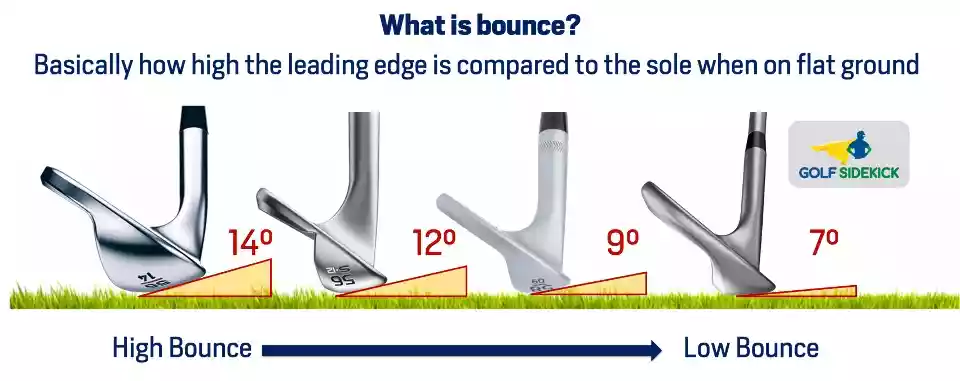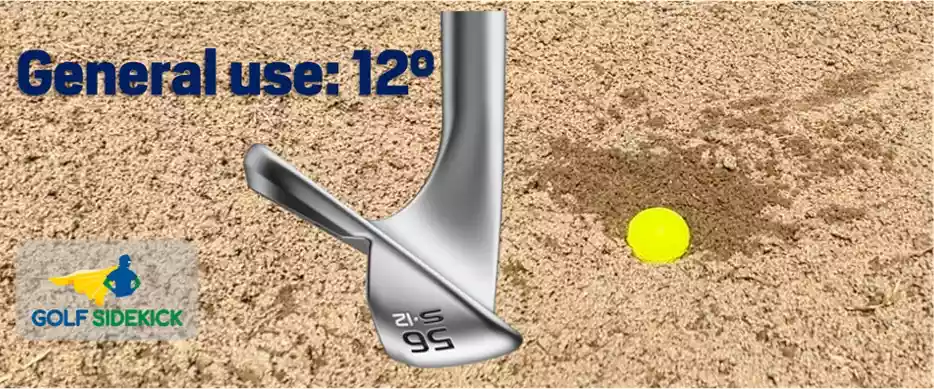Last Updated on January 7, 2024 by Matt Greene
Sand wedge bounce is one of those mystical topics everyone talks about and you even hear pros and other amateurs saying things like "use the bounce" when you're chipping or pitching. And you know what? No one knows what they are talking about.
So here's the real deal, no BS.
What is bounce in a golf wedge?
Bounce is the amount of sole on the bottom of the wedge there is to literally bounce off the ground when you hit the ball.
It's that simple. When people tell you to use the bounce, there is no conscious notion of 'using the bounce'. To hit any golf shot, the club must bounce off the turf otherwise we just dig into the turf like a spade.

If you hit a chip, the club makes contact with the ground, bounces off the ground slightly and contacts the ball. The reason we need bounce in a club is so the turf interaction with the club is appropriate for the shot.
So if you play on soft ground, you want the higher bounce to be able to 'bounce more' when you hit the ball so the wedge does not get stuck in the soft ground. When you hit a wedge on firm ground, you do not want the golf wedge to bounce much off the hard surface. It will bounce, and then hit the ball in the equator, making you thin the ball into oblivion.
Is a Sand Wedge Bounce of 10 or 14 Better?
- If your golf course has firmer ground and you clip the ball off the surface in fear of blading the ball, then you should get a wedge around 10 degrees of bounce. Usually your bunkers will also be firm so 10 degrees bounce in a sand wedge or less is best.
- If your course is softer and sometimes a bit moist, with soft lush grass, and you make divots after you hit the golf ball, use a sand wedge bounce of near 14 degrees.
If you have the correct bounce angle on your wedges, you can hit more confident shots with your sand wedge. And as we know, the 56 degree sand wedge is a serious scoring club.
Which is the best sand wedge bounce for your Conditions?
I've played golf in SE Asia, USA, South America, Scotland, England, Finland and South Africa.
That's kikuyu, bent, bluegrass, poa, fescue, rye grass, paspalum, all strains of bermuda. With that, I've tried every wedge bounce and loft angle so I'd like to save you some time with this article to get the right wedge.
Firm conditions, low bounce and a lot of the sole grind away.
Soft, wet, fluffy conditions, high bounce with a big fat sole.
Most 56 degree sand wedges have a bounce of between 8 and 14 degrees so you can adjust your selection based on the conditions as mentioned just above.
The very best way to figure out the right bounce of your 56 degree, is to have a wedge fitting with a pro and he will adapt your wedges to your swing and conditions.
Why Use a Sand Wedge With High Bounce (10 to 14 Degrees)?
Most golfers, by default, unless playing in the outback or some other hardpan golf course, should buy a wedge with higher bounce angle.
The wedge has been designed to 'bounce' off the ground to add forgiveness when hitting the golf ball.
When you hit a hybrid, do you notice how much easier it is than a 4 iron?
That's because of the wider sole and skimming turf interaction. It's a similar concept to the wedge.
A sand wedge with high bounce is between 10-14 degrees of bounce.
You should use a sand wedge with the higher bounce if:
- You hit steep with your golf swing with deep divots.
- Your wedge shots are often fat.
- You golf course has soft ground, and soft fluffy bunkers.
- You have more longer rough around the greens than tight short grass

Why Use a Sand Wedge With Low Bounce (6 to 10 Degrees)?
A low bounce sand wedge is for a golfer who plays on firmer conditions with much tighter lies than most courses and a golfer who likes to see a more open club face at address when chipping off tighter lies.
With a low bounce sand wedge, there is a lot less sole in the bottom to bounce off the ground so a lot of the time, a golfer needs to catch the ball clean off the turf, or the turf is so firm, that the bounce is sufficient for the tight ground.
When you have a low bounce wedge, you can change the face angle quite easily because there is less sole to pick the leading edge up off the ground.
6 to 10 degrees of bounce is normal for a low bounce sand wedge.
Lower bounce on a sand wedge is best for you if:
- you have a shallow swing and your divots are minimal
- your course has firm ground and hard pan as well as firm sand in the bunkers
- you like to hit some spinny open-faced wedge shots like a wizard
What is the Best Bounce for a 56 Degree Wedge?
Sand wedges have 56-degrees of loft - usually denoted with an S on the sole of the club and there is sometimes even another number on the sole, indicating the bounce of the club.
The best bounce for a 56 degree wedge for most golfer is about 12 degrees. This is a versatile number right in between the low end of 8 degrees and the high end of 14 degrees. You can play most courses with a 12 degree bounce sand wedge and enjoy your golf.

Which Bounce For Every Different Course Condition?
From my experience in all the conditions of the world I have seen, you can use a 12 degree bounce wedge for most, but some conditions really need a specific bounce on the 56 degree wedge. It's important to know when to use certain wedges.
Soft Sand
Higher bounce is always the best choice in soft sand. The aim of bunker shots is to slide the club under the ball and skim that wedge to bounce up and let the ball out on a magic carpet ride. 12 to 14 degree bounce will work best.
How do you know if your sand is soft?
When you hit the sand shot, does the sand fall back into itself and leave a very round divot in the bunker? That's soft. When you walk into the bunker, does it sometimes go up to your ankle?
That's soft fluffy sand.
Medium, Wet and Firm Sand
In firm sand, wet sand and medium sand, you need less bounce because the sand will not allow the fat sole to get in deep enough to allow enough space to bounce. You will blade the ball across the green a lot.
I love to use wedges with 8 to 10 degree bounce angle for firm courses and firm sand, but 10-12 degrees of bounce for medium sand.
How do you know if your course is medium or firm?
When you walk into the bunker, the sand will either not give way for firm sand, or will only dig your shoe in up to the rubber sole. Wet sand is pretty easy to identify. If it's wet, then the sand is wet.
Deep Soft Grass Rough
From my time in the Eastern states of the USA, I found the wedge needed for soft long grass with soft conditions under the grass, a bounce of 10 to 14 degrees is preferable.
The soft condition under the grass will need some extra bounce but the long grass can tangle the leading edge if there is not enough bounce.
With more bounce, the club is heavy and thick soled, to glide through the grass.
Tight Lies in Fairways and Fringes Next to The Green
When you watch the Masters on TV, most of those pros will be using a variety of wedges but those tight lies will make your hair stand on end, thinking of blading it across the green into the hazards.
A low bounce between 6°-10° will make you feel better about making crisp clean contact especially if you need to open the club face a little bit.
When you use high bounce wedges on tight lies, the leading edge can often meet the ball in the equator and your score sky rockets.
Best Sand Wedge Manufacturers
The most famous wedge makers are Cleveland, Titleist, Mizuno, TaylorMade and Callaway.
- Wedge for mid handicappers if you play off handicap 9-16.
- Wedges for high handicappers if you play off handicap 17+.
- Best 56 degree wedge for bunkers if you have trouble getting out the sand.
Some of the best options on the market for different bounce and grind options:
- Cleveland RTX 6 Sand Wedge (Many options: Full Bounce, Mid Bounce Low Bounce, X Low Bounce)
- Cleveland Smart Sole 4 (Sand Wedge with huge bounce)
- Titleist Vokey SM6 (5 different options and famous for wedge fittings)
Can you use a sand wedge in the fairway?
Yes. You can hit a sand wedge from the fairway. Usually you will use it from between 10 and 80 yards depending on your preference for partial shots.
In my experience, the bounce makes a big difference on shots from the fairway with a 56 degree wedge.
If the fairways are baked firm with gard ground underneath, the club will skim and bounce into the ball, causing you to thin the ball.
If the fairways are wet and the bounce is too low on the wedge, you will dig deep craters into the ground.
Matching the wedge to the conditions is equally important even for full shots.
Can you use a 56-degree wedge in the sand?
56 degree wedges are called sand wedges and so most people will start golf playing this club out the sand.
it is the easiest club for most people to use in the bunkers because of the design. It's one of the only clubs in the golf bag that has not changed much over the years.
Every iron loft has been reduced by 5-15 degrees in loft but the sand wedge has stayed 56 degrees for 50 years and that is testament to how well it works from the sand.
What bounce wedges do the pros use?
When conditions were firmer and unfriendly in the old days, pros preferred low-bounce wedges, but current PGA Tour pros use wedges with between 12 or 13 degrees of bounce.
Final Thoughts
By now I hope you know enough about the bounce of a wedge to make an informed decision.
While your conditions and the way you strike the ball makes a big difference to the bounce you should use in your 56 degree, I highly recommend a wedge fitting. The pro will know your local conditions, your swing style and be able to set you up with a decent set of 2-3 wedges with the correct bounce and loft angle for you specifically.
You can see my guide on how to get out of every bunker type as well as the video here.
You can check out my guide on how to chip and also the video series below.
